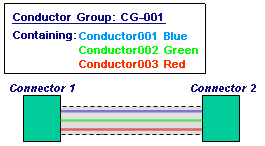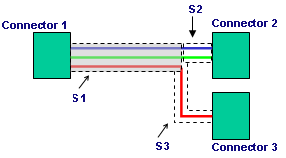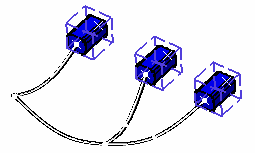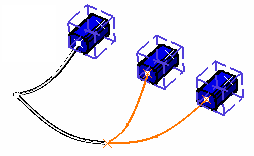About Routing | ||
| ||
Routing Process
Once the system knows where the conductor ends are, routing can be done. You can also use a business rule to check the compatibility of the conductor to be routed and the set of segment to be routed through.
When conductors are routed:
- A network is built based on connectivity:
- If any link is defined between electrical geometry and electrical physical system, then the network will be searched in only the connected electrical branch geometry.
- If no link is defined between electrical geometry and electrical physical system, then the network will be searched in all the electrical branch geometries.
- Entry points in the network are retrieved based on the segment connection points or cavity.
- The algorithm is launched to find the route for all the conductors.
A conductor group is ready for routing if all its constituent conductors and conductor groups are ready for routing. This means in particular that all ends of constituent conductors are correctly mapped.
You can create your own compatibility table to apply separation conditions when routing. This table is taken into account via a separation code file setting ().
You can use a business rule to check the compatibility of the conductor to be routed and the set of segment to be routed through. Thus, a message appears from the rule's context.
![]()
Calculation of Segment Diameter
By default, when the conductors are routed, segment diameters are automatically calculated. Segment diameter is based on the diameter of constituent conductors and/or conductor groups and different formulas are used.
- Diameter of Segments containing Conductor G-roups
- Diameter of Segments containing Individual Conductors
- Formula Used
To change the default option, see Segment Update.
Diameter of Segments containing Conductor Groups
The diameter of segments containing conductor groups is computed in two different ways depending on whether the conductor group is routed between two connectors, or between three or more connectors.
Note: The same rules apply when updating the bend radius.
Conductor Group between Two Connectors
The segment diameter is based on the conductor group.
The formula used depends on the number of conductor groups in the segment. In the example below, the segment contains one conductor group. The diameter of the segment is the same as that of the conductor group.
Note: If you change the diameter of individual conductors, this will not affect the diameter of the conductor group and segment.
Conductor Group between Three or More Connectors
- If all the conductors in the group are routed together through the segment (S1 in the illustration below), the segment diameter is based on the conductor group.
- If the conductors in a conductor group are routed separately through segments (S2 and 3 in the illustration below), the segment diameter is based on individual conductors.
The formula used depends on the number of conductor groups and/or conductors in the segment.
Diameter of Segments containing Individual Conductors
Segment diameter is computed based on the conductors it contains, and segment geometry is updated.


Formula Used
The formula used depends on the number of conductors in the segment.
When the Segment Update: Diameter and bend radius to its content check box is selected in the Tools > Options > Equipment > Electrical Harness Discipline > Electrical Assembly Design > Conductor Routing tab:
| Number of Conductors and/or Conductor Groups | Segment Diameter |
|---|---|
| 0 | no change |
| 1 | conductor (or conductor group) diameter |
| 2 | Sum of conductor diameter |
| 3 and above | [(1+x)*sum of (conductor diameter^2)] ^ 0.5 |
where 0 <= x <= 1 is the percentage added
A typical example:
| Segment | Constituent Conductors and Conductor Groups | Number of Conductors or Conductor Groups | Segment Diameter |
|---|---|---|---|
| S1 | All conductors in group are routed together | 1 | conductor group diameter |
| S2 | Only two conductors of the group are routed together | 2 | 2 * diameter of the largest conductor |
| S3 | Only one conductor of the group is routed | 1 | conductor diameter |